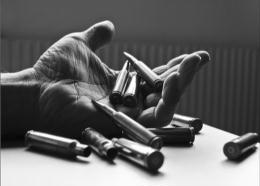

 The Accurate Reloading Forums
The Accurate Reloading Forums  THE ACCURATE RELOADING.COM FORUMS
THE ACCURATE RELOADING.COM FORUMS  Rifles
Rifles  Small Calibers
Small Calibers  twist rate compared to muzzle velocity?
twist rate compared to muzzle velocity?Go  | New  | Find  | Notify  | Tools  | Reply  |  |
| One of Us |
Since the rotations per second is a function of the twist rate and the velocity I'm wondering if a higher muzzle velocity that results in the same rotations per second would stabilize a similar bullet. Example: .224" 90 gr Berger bullet, requires 1-7" twist to stabilize. maximum velocity for 90 gr in a 223 Rem is 2600 fps, with a 1-7 twist, computes to 4450 rps. Same bullet in a 220 Swift, max velocity 3100 fps. To get the same rps, only a 1 - 8.35" twist is needed. If the stability is a function of rps, then seems to me that a slower twist could stabilize as long as the velocity was high enough. Or, ??? | ||
|
| One of Us |
Velocoty males a difference to stability, but not as much as one might assume. There are several online stability calculators offered by JBM and Brian Litz amd Berger amongst others. If you play around with them you will see what I am suggesting. Of course these are all formula based and if one questions the formula well then your view of the impact of velocity on stability may change compared to that for the factors currently used by most. | |||
|
| One of Us |
I'm interested in this discussion. I always assumed it was strictly the twist rate, and not the resulting RPMs. | |||
|
| One of Us |
Velocity is shed pretty fast where the spin stays fairly constant . It does slow but not as much as the vel is shed . That's why a bullet may shoot good at 100 but keyhole at 2-300 , if it was marginally stabilized . | |||
|
| one of us |
Look up the complete Greenhill Formula. All the online calculators are just simplified version s of it. Note that it gives you maximum length that a given twist/velocity can stabilize (it was designed for the use of elongated bullets in existing BP cannons). | |||
|
| one of us |
Yes, it is true that the higher the velocity the slower the twist that will stabilize a given bullet. However, as others have indicated, the difference in stability imparted by velocity is not great: The difference in stability between, say, 3200 fps and 2800 fps, is fairly minimal. Early Weatherby rifles used a fairly slow twist, apparently on the theory that the slowest twist that would stabilize a bullet was both the most accurate and would allow a higher velocity at the same pressure. Both theories are probably true to a small extent, but it turned out that the ultrafast .300 Weatherby 180 grain bullet at 3200 fps was not appreciably more stable than the same bullet from a .308 Winchester at 2500 fps in the same 1-12" barrel. Which is why Weatherby eventually went to a 1-10" barrel. | |||
|
| One of Us |
a faster twist will affect the terminal performance of a hunting bullet. and over spin can cause a bullet to fly point up or even corkscrew until it settles down. your spin numbers are a bit off. it isn't unusual to see rpm numbers over 200,000 | |||
|
| one of us |
I can squeeze my 17REM up around 4500fps in a 1:9" barrel that sums up to @ 360.000rpm. | |||
|
| one of us |
ok lets simplify it: Force = velocity dependent Bullet stability in flight, as far as the static stability side of the stability triangle concerns is dependent on the ratio between two forces. The overturning torque force and the gyroscopic torque force. When the ratio of the gyro force relative to the overturning force reaches unity the bullet is deemed statically or gyroscopically stable ! ie Fg/Fo =1 or > 1 this ratio is otherwise known as the stability factor. The overturning force is velocity dependent and the gyro force is also velocity dependent albeit angular velocity dependent. in air the dependence is not big but as soon as the bullet transitions to a dense fluid like medium this dependence becomes huge ! tissue is a 1000 times more dense than air ! | |||
|
| One of Us |
Better to use a slightly tighter twist with known/demonstrated stability in all anticipated shooting conditions than spend one's brain power trying to justify a marginal twist that will work in some situations but will be marginal to unstable in other conditions. Lots of competitive shooters have horror stories about loads that shot well in ideal conditions but got really twitchy when the wind began to blow. | |||
|
| One of Us |
It's bullet LENGTH...NOT BULLET WEIGHT...and M.V. that needs to be considered carefully when trying to determine bullet stability...OPTIMUM STABILITY and it's NOT JUST ONE TWIST RATE as, depending on caliber, one twist rate will stabilize SEVERAL bullet lengths. Take a look at the programs that provide twist rates and FORGET all the fine gobbledygook with the fancy twist formulas...those are just for arguing about the minutia or blowing giant smoke signals. Twist rates have been THOROGHTLY deconstructed by rifle makers so YOU don't have to get headaches...EVEN for mile marker shooters. Following rifle maker caliber recommendations will keep you in the ballpark UNLESS decide to go OUTSIDE of the "normal" bullet weight parameters...THEN you might want to reconsider a twist rate OPTIMUM for THAT particular bullet design. Twist rate formulas require just 4 parameters...Bullet dia, bullet length and muzzle velo and whether or not it has a boat tail. I've shot a lot of Hornady 60 gr SP's(0.700") at one time in my 1-14, 22-243 MIDD, up around 3700 fs, optimum is 1-13. It was always a bugholer once I found the sweet spot...BUT...IT WOULDN'T stabilize the 60gr HP(0.795" OPT 1-12) OR the VMax(0.870" OPT 1-10)...ALL THE SAME BULLET WEIGHT but DIFFERENT BULLET LENGTHS. I also shoot a lot of 204, 224, 6mm and 308 and when I mess about with twist rates other than "normal" I end up with a barrel that will shot only one or two bullets as specific velo's or a jack handle. You also have to consider pressure AND bullet construction. The faster the twist the higher the pressure and the higher the rotational energy/torque produced. I started shooting this hot rock back in the mid 70's and there were only a few bullets that would stay together then and even now...Nosler's are the only bullet I trust from 50 gr and up at those velo's NOT to come apart in a puff of blue/grey smoke. LUCK | |||
|
| one of us |
Hmmm no ! The Formulae are mathematical derivatives of physical attributes of mass in motion as it pertains to flight and the effects of aerodynamics forces on this mass in motion. Its mass and distribution of mass that is important and it's not gobbledygook ! A gyro functions because you spin mass about a centre of gravity. The resultant force vector ( again mass dependent ) counters the force vector that tries to overturn the bullet. The fact that the formulae claim length is because they all assume a standard mass density. Problem is that mass is not evenly distributed ( HP bullets) and some bullets are made of two or more materials of differing mass, hence then the propensity of the formulae to be approximate only. The length is important only as far as it is representative of the length of the lever arm of the various torque forces at play. The critical parameters of the bullet is the position of the CG of the bullet relative to the point of pressure and is represented as the axial moment of inertia and then the transverse moment of inertia. In other words the spatial distribution of MASS about the centre of gravity. | |||
|
| One of Us |
Of course you're right, but isn't that just what I said...just compacted so we mere mortals can/could possibly understand it....NO PhD required, physics or geek speak...just straight talk...the physics lesson is well received by those that can understand the minutia, but luckily all that is ALREADY taken into consideration by the twist rate programs and nothing else is required. Apparently multi material bullets or mass not evenly distributed doesn't concern a bullet in flight to any great extent otherwise all those HP's, jelly belly tipped and lead/copper projectiles would just go where they pleased. I used gobbledygook in reference to what many people think when formulae are seen...didn't mean to ruffle any feathers...a large percentage of the population think that term or something similar if you presented them with ANY relatively simple formula...Blind them with brilliance or baffle them with bullsh**...isn't that how it goes. All the mathematics, physics and fine details are already worked out by the PhD's WELL before it filters down to the hunters and shooters otherwise this would be a very dull sport limited to the Illuminati. LUCK | |||
|
| one of us |
Quite right. Two bullets of the same weight and length may not stabilize similarly because of the distribution of weight (mass) within the bullet. One reason that plastic-tipped bullets and bullets with a long hollow point, that are considerably longer than a conventional cup-and-core bullet, will still stabilize in a twist that wouldn't stabilize some other bullets of the same length is due to the mass distribution within the bullet. A bullet's stability which is made longer due to having a long, sharp boattail is impacted differently than one made longer due to having a long, sharp (and perhaps hollow) ogive. | |||
|
| one of us |
For purposes of home loading companies do not publish the critical dimensions of their bullets and one can understand why not. The average reloader / shooter will have no use for that data. Most Plug and play ballistics calculators such as Win Gyro have the data already pre loaded and once a specific bullet is selected from a list the program does the rest given the chosen velocity window and barometric condition. I am critical of the "de novo fast twist rate" adherents as it relates to terminal bullet performance as well as long range shooting. There is certainly place for fast twist rate barrels but then their effects and application need to be understood. We have a highly acclaimed thread on bullet behaviour right here on AR with a myriad of assumptions and recommendations made that are factually incorrect. For one claims are made based on tests performed when the "test:" actually does not test for the premise made. Tests are only valid if the test design tests for a premise made ! Designing such tests are actually very difficult and one could argue outside the realm of "home ballistics" testing. The data regarding a bullets design in terms of location of CG and then distribution of mass and as described by the axial and longitudinal moments of inertia is critical to understand how that bullet would behave and more so what the expected wounding profile would look like ( this is for pointed FMJ or solid bullets) | |||
|
| One of Us |
For those that want more info, Wikipedia has several very nice, layman friendly tomes on George Greenhill's and Don Miller's twist formula along with additional list of places to go to find MORE info. Powley has some excellent publications on ballistics also. The formulae asks for bullet diameter, bullet length and velocity (through a stability factor calculation) WITHOUT getting too deep in extraneous terminology. K.I.S.S. principle in full cry, along with the required "constants" and explanations for that requirement. I don't understand the problem with assumptions...you can't arrive at any supposition without making and testing assumptions otherwise without the use of constants mathematics would be chaos and we wouldn't even have accurate watches much less GPS. EVERYONE from Galileo down through the centuries used assumptions to test theory. All this fancy talk is lost on 95% of the shooting public...they don't want it or even care...they want a simple answer to a complicated problem that can be reduced in complication simply and effectively by reducing the complexity of the problem mathematically or through testing and deriving a simpler formula. Simply put...is it right to be right when all you're doing is confusing the issue and turning off those seeking answers. Surely those with the capacity to handle higher math/physics have the ability to speak in layman's terms on a layman's forum. It should be the responsibility of those to make this simple game as simple as possible. LUCK | |||
|
| One of Us |
I wouldn't try to compensate velocity over ROT more than 1/4 to maybe (big maybe) 1/2 turn of twist, and consider this topic on the verge of sheer folly. Dennis Life member NRA | |||
|
| one of us |
A bit off the subject, but the RPS/Mv comparison holds especially true for round balls in muzzleloaders. For low velocity sub sonic squirrel loads in my .36 I prefer 1-48" twist. For loads approaching 2000 fps in my .54s I prefer 1-70" twist. GOOGLE HOTLINK FIX FOR BLOCKED PHOTOBUCKET IMAGES https://chrome.google.com/webs...inkfix=1516144253810 | |||
|
| One of Us |
The complete Greenhill formula uses a 2 stage multiplier that is determined by velocity and another that is an adjustment for the density of the bullet. The variables are the diameter of the bullet, squared, as the numerator and the length of the bullet as the denominator. This leaves one to wonder what actually causes the bullet to stabilize? which is the original question. If a particular bullet stabilizes at a specific rotation speed, what is the difference in stability if that rotation speed is reached by a higher velocity in a longer twist barrel compared to a shorter twist at slower velocity? | |||
|
| one of us |
Ray B: I shall try again as I did before my attempt at doing so was shot down in flames So to recap: The stable condition is a triangle consisting of 3 sides: 1. The static ( gyroscopic) stability condition 2. The dynamic stability condition 3. The tractability condition. One is achieved when the overturning moment induced by the wind force acting on the point of pressure is negated by the "gyroscopic force" When unity between these two forces is reached we can say the projectile is statically stable. A obligatory side effect of spinning a bullet is that a rolling motion is induced in the bullet called precession and superimposed on this nutation. Precession is a slow arm motion whist nutation is a fast arm motion. If this rolling motion damps out over distance then the bullet is said to be dynamically stable. ie the bullet "goes to sleep" The third side of this triangle is called the tractability condition. This is the ability of the bullet's long axis to coincide with the arc described by its direction of motion. The down side to static stability is that if the bullet is spun to fast it becomes less tractable especially on the down side of the arc of motion. This condition exists when the bullet is "over stabilized) Sf = 1/F Where Sf = stability factor and F = tractability number So as to the original question regarding velocity and twist. This is a mathematical rendition of the Gyro theorem:  Where: S = stability factor Ja = axial moment of inertia Jq = transverse moment of inertia w = spin rate M = overturning moment If we further break this down we see a dependence on bullet velocity , target (Air)density, bullet factors such as presenting surface area etc. The overturning moment (M) looks like this: This as stated is the effect of wind force on the bullet. If spin is negated the bullet will tumble because of this moment M  I did some calculations before on the 458 Win bullet to show how velocity affects stability 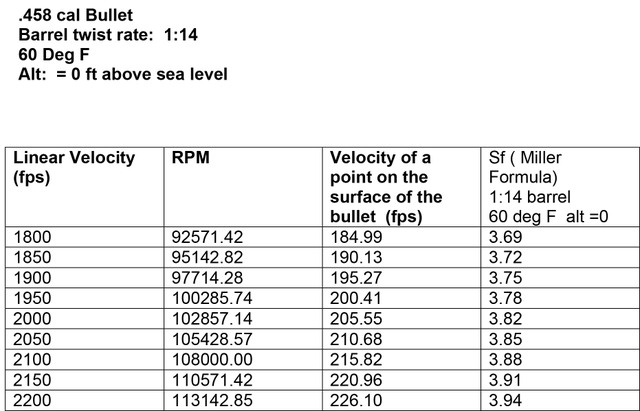 I specifically chose velocities in the "normal velocity window" for a 458 win ie 1800 fps to 2200 fps. One can see what the angular velocity is expressed as RPM but also then the velocity of a point on the surface of the bullet expressed in FPS and lastly the Stability factor. We see from this that there is an increase in Sf between 1800 fps to 2200 fps but that the incremental increase in Sf is actually very small. From 1800 fps to 2200 fps we see an increase in SF of 0.25 only. This is what happens when twist rate is changed 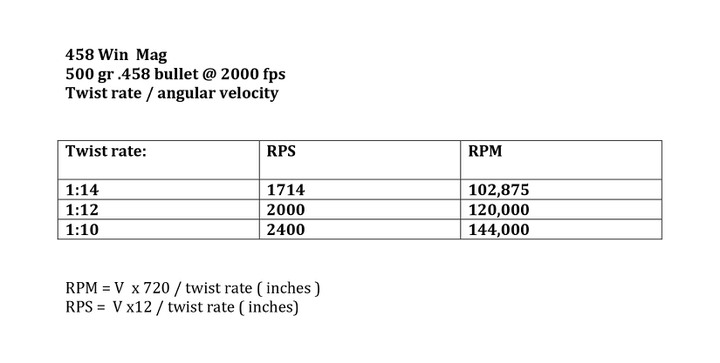 It also then begs some discussion regarding a round ball shot from a muzzle loader. Why would one spin a round ball when te ball is deemed stable ! If we assume a perfectly round ball and the ball does not deform: The ball is stable based on the above. The CG coincides with the centre of form of the ball so that the Ja = Jq By this then the ball is statically stable and also the dynamically stable it is also tractable ! So why do we fire balls from rifled barrels to improve precision ? The reason is that lead balls deform under acceleration in bore and are no longer round, the assume a elongated shape and thus Ja is no longer equal to the Jq and what is more the CG is no longer coincidental with the centre of form. | |||
|
| One of Us |
Let me be more precise in my question: Two identical bullets are fired; 1 from a barrel with a faster twist than the other but at a lower muzzle velocity so that both bullets have the same rate of spin. At 100 yards the faster bullet has lost velocity such that it is now at the same velocity that the slower bullet was traveling at the muzzle. Since the spin does not slow proportional to the loss in velocity, the faster bullet at 100 yards has the same velocity and spin rate as the slower bullet did at the muzzle. Since both bullets at those points have the same velocity and rotation, if one is stable, would not the other be stable? Please don't tell me how to build a clock, I'm only asking what the time is. | |||
|
| one of us |
If both were gyroscopically stable at muzzle both would be stable downrange ! But only in terms of static ( gyro ) stability. They may not be equal in terms of dynamic stability. The Sf gets bigger downrange but not over the whole distance of possible maximum flight. If a bullet is fired at a high angle of departure to get maximum range say 40 deg then at some point the Sf will stop increasing and it will regress. | |||
|
| One of Us |
I don't see the answer to the question: If two identical bullets have the same velocity and rate of rotation; but one achieved it via a quick rate of twist while the other achieved it with a faster initial velocity; but now the faster bullet has slowed so that both bullets now have the same velocity and rate of rotation; won't they both be stable? Yes No | |||
|
| one of us |
Yes both will be stable ! If a bullet is stable @ muzzle it will be stable downrange ! But here is the thing: It is advised that one should start with a Sf of no less than 1.5 to compensate for possible changes in barometric pressure. The reason for this is that the overturning moment is proportional to air density. As I have shown with the 458 the difference in Sf at muzzle is only .25 for velocity range between 1800 fps to 2200 fps. It is better to achieve stability at muzzle by choosing a appropriate twist rate for the velocity window you are going to shoot at as opposed to a marginal twist rate and shooting at higher velocities. 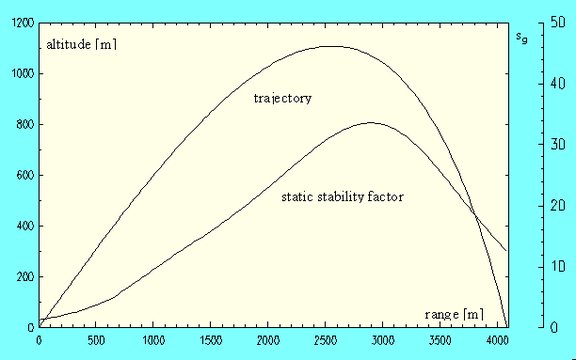 This graph shows the effect of altitude ( barometric pressure) On the right side X-axis. Sf > / = than one is deemed stable. this from McCoy: For the 308 Sierra 168 gr 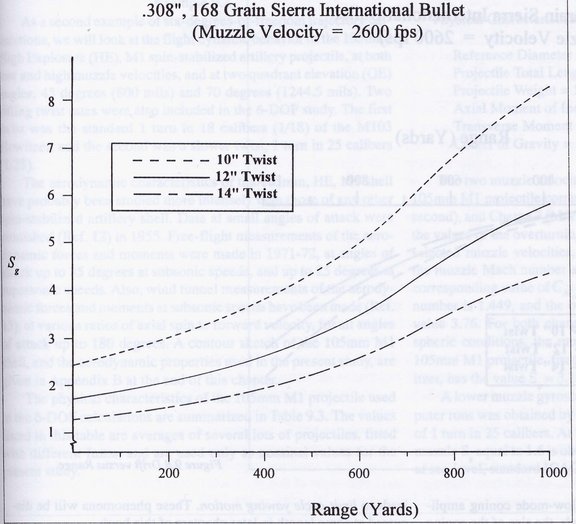 But look what happens to yaw ! ie dynamic stability ! Whilst the bullet becomes statically stable it becomes dynamically more unstable, after going to sleep yaw starts growing 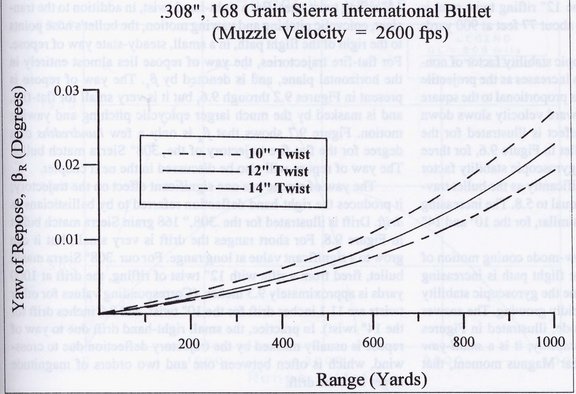 | |||
|
| One of Us |
This discussion is beyond me but, just for clarification: is the variable that caused the one bullet to slow down still present? If referring to just that instant in which both are at the same velocity, disregard. Thank you. | |||
|
| one of us |
this conversation has been going on for decades, some will make wild statements and if that doesn't work they will founder you with BS..Some will be so complicated that they are impossible to understand, albeit they may in fact be 100% correct.. The best way is to test the gun and caliber in question because all technology taken into account may not apply to every rifle or caliber. The only way to arrive at a correct determination is to test the gun in questionat the range, its an individual, and may not adhere to the norm. Ray Atkinson Atkinson Hunting Adventures 10 Ward Lane, Filer, Idaho, 83328 208-731-4120 rayatkinsonhunting@gmail.com | |||
|
| One of Us |
Length has been mentioned as being important. Maybe we need a brutally honest female to log in on this. | |||
|
| one of us |
Carpetman, that's penetration, and not amiable to twist.. To complicate this thread which has been thoroughly explained by Alf, one has to take into account the effect of the bullet in flesh in terms of killing effect, penetration, etc. and one can certainly void the other when taken to extremes. That is why a bullet comes apart as both the velocity and spin puts pressure on the bullet. Probably a good reason why not to get to technical in this matter, the standard has been set so use it, A 270, 30-06,308 and many others are proper or best at 1x10 or 1x12, a 7x57 is 1.9. This applies in most cases..Keep in mind the more spin and velocity, the more damage and/or expansion and less penetration to a bullet, so a happy medium is in order...My basic suggestion to those that aren't into such matters, and/or wanting to keep their sanity. Ray Atkinson Atkinson Hunting Adventures 10 Ward Lane, Filer, Idaho, 83328 208-731-4120 rayatkinsonhunting@gmail.com | |||
|
| One of Us |
We all ask these questions about bullets, velocity, twist, terminal performance over and over but our mistake is that we seek only the easy answers. As Alf has demonstrated over and over, their are answers to almost every question. They are not necessarily easy. For example your question: I don't see the answer to the question: If two identical bullets have the same velocity and rate of rotation; but one achieved it via a quick rate of twist while the other achieved it with a faster initial velocity; but now the faster bullet has slowed so that both bullets now have the same velocity and rate of rotation; won't they both be stable? Yes No What could you learn from a yes no answer that would be meaning full to the intent of a rifle firing a bullet over varied ranges into varied mediums, in varied conditions? Not much is that simple answer to that. What does "stable" mean anyway? Depends on all the other factors. Alf always answers the question but rarely, if ever, falls into the trade of simple versus complete and the trap of non-learning that creates. And by the way; none of his answers is baffling with BS because there is no BS included. Whether one is baffled or not is decided by one self. Happy Shooting! "The liberty enjoyed by the people of these states of worshiping Almighty God agreeably to their conscience, is not only among the choicest of their blessings, but also of their rights." ~George Washington - 1789 | |||
|
| Powered by Social Strata |
| Please Wait. Your request is being processed... |
|
 The Accurate Reloading Forums
The Accurate Reloading Forums  THE ACCURATE RELOADING.COM FORUMS
THE ACCURATE RELOADING.COM FORUMS  Rifles
Rifles  Small Calibers
Small Calibers  twist rate compared to muzzle velocity?
twist rate compared to muzzle velocity?

Visit our on-line store for AR Memorabilia

